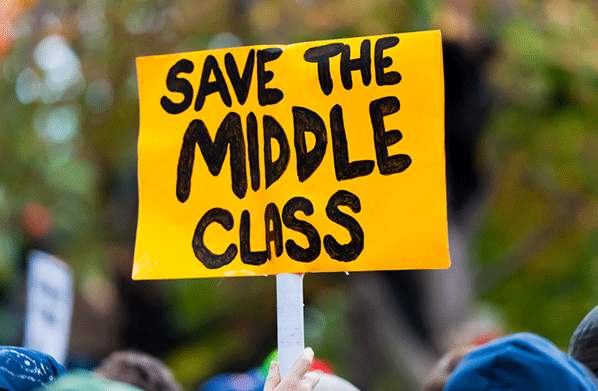The middle class is the backbone of our country. It’s been an aspiration for the poor or those new to our shores. Yet, less than half of Americans now view themselves as being in the middle class, and when asked, they think life in the middle is tough.
We have the economy to blame for our shrinking middle class. Americans are struggling to bear the weight of a recession that left good-paying jobs behind, stagnated incomes, and drove housing costs higher. Across the states, the differences are even more stark.
Early this year, Pew asked Americans where they thought they fell on the economic ladder and found surprising results. The percent of Americans who identify with the middle class dropped to below half (44 percent) from a high of 53 percent in 2008. Simultaneously, the share of Americans who identify themselves as in the lower or lower-middle class rose from 25 percent to 40 percent. There’s even shifting at the top of our economic ladder. In 2008, about one-in-five Americans (21 percent) said they were in the upper or upper-middle class. Today, only 15 percent place themselves at or near the top.
Mapping the middle class over states, we see that in each of the 50 states, the share of middle-class families has shrunk from 2000 to 2013. Pew categorizes “middle-class” as incomes between 67 percent and 200 percent of the state’s median income. In some of the hardest hit states such as New Mexico, Wisconsin, and Ohio, the share of middle class families had fallen by more than 5 percentage points shifting the percentage of middle-income families below half of the state’s population. In addition, the number of families spending more than 30 percent of income on housing (a recommended standard) has grown indicating further strain on middle-class families.
CBS reports:
"That the people in the middle class are a shrinking portion of the population in all likelihood will have far reaching societal impacts," said Scott Greenberger, the editor of Pew's Stateline unit, which analyzed the state-by-state trends. "There is something to be said for political and economic stability" with a stable or growing middle class, he added.
Of course, not everyone agrees on what constitutes the middle class, and a middle-class lifestyle can vary depending on the cost of living for a particular city or state. A middle-of-the-pack family in San Francisco, for instance, may need income of well over $100,000 to afford housing and food, simply because of the higher cost of living there. A family in Nebraska, though, may count as middle-class with an income as low as $39,000.
…
"In most states, the growing percentage of households paying 30 percent (the federal standard for housing affordability) or more of their income on housing illustrates that it is increasingly difficult for many American families to make ends meet," Pew noted.
…
California is one state where residents are increasingly challenged by those trends. The median annual income in the state has slipped to $60,190, down from an inflation-adjusted $65,445 in 2000, according to Pew. At the same time, housing prices have surged, pushing up the ranks of people struggling to afford rent or mortgage payments. About 44 percent of Californians now pay more than 30 percent of their income on housing, up from 38 percent in 2000, Pew noted. The state's share of middle-class families has declined 3.2 percentage points to 43.5 percent.
While the President touts his middle class economics policies as a way to get us back on our feet, Americans just aren’t buying it.
Before submitting his budget proposal to Congress in February President Obama said that “Over the last six years, we’ve seen that middle-class economics works.” Not only is that not true when we look at the 30 million people who are unemployed or underemployed, stagnant wages, and the persistent wealth gap, but Americans aren’t buying it. In a recent Pew poll, 72 percent said that the government’s economic policies since the recession have done little or nothing to help middle class people, and nearly as many say they have provided little or no help for small businesses (68 percent) and the poor (65 percent).
These changes in perceptions represent the erosion of decades of progress in the incomes and quality of life for generations of Americans. That millions of Americans feel like they are falling behind rather than moving ahead bodes poorly for a nation that should be a leader in the world – demonstrating the prosperity that democracy and economic freedom bestows on a nation.


